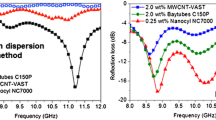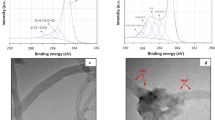Abstract
The high performance-multiwalled carbon nanotubes (MWCNTs) reinforced epoxy resin nanocomposites have been fabricated using industrially viable fast process of dispersion with high speed homogenizer (~30,000 rpm). This high energy homogenizer was found to be a successful technique for uniformly dispersion of MWCNTs and confirmed by scanning electron microscopy. Herein, two different lengths of MWCNTs, i.e., long length of ~350 μm aligned bundle (l-MWCNT) and short length of 1.5 μm (s-MWCNT) were used as reinforcement in epoxy resin. The effect of length of MWCNTs on the mechanical, electrical, and electromagnetic interference (EMI) shielding properties of MWCNTs/epoxy nanocomposites is investigated. The percolation threshold was obtained at 0.02 wt% for l-MWCNT compared to 0.11 for s-MWCNT. Due to very low percolation threshold and enhanced electrical conductivity (1.37 × 10−3 S cm−1 for 0.5 wt% l-MWCNT and 0.95 × 10−3 S cm−1 for 0.5 wt% s-MWCNT), absorption dominated EMI shielding effectiveness was achieved −16 dB for l-MWCNT compared to −11.5 dB for s-MWCNT with 0.5 wt% loading in Ku-band (12.4–18 GHz). This is the highest reported value for MWCNTs-epoxy composites for low loading level of 0.5 wt% at 2.5-mm thickness. In addition to this, flexural strength of the composites was found to be 125 MPa at 0.3 wt% for l-MWCNT and 113 MPa at 0.3 wt% for s-MWCNT from 95 MPa of pure cured epoxy suggesting the usefulness of this of material as strong microwave absorber.










Similar content being viewed by others
References
Ayatollahi MR, Shadlou S, Shokrieh MM, Chitsazzadeh M (2011) Effect of multi-walled carbon nanotube aspect ratio on mechanical and electrical properties of epoxy-based nanocomposites. Polym Test 30:548–556
Bai JB, Allaoui A (2003) Effect of the length and the aggregate size of MWNTs on the improvement efficiency of the mechanical and electrical properties of nanocomposites—experimental investigation. Compos A 34:689–694
Balberg I, Anderson CH, Alexander S, Wagner N (1984) Excluded volume and its relation to the onset of percolation. Phys Rev B 30:3933–3943
Bauhofer W, Kovacs JZ (2009) A review and analysis of electrical percolation in carbon nanotube polymer composites. Compos Sci Technol 69:1486–1498
Bryning MB, Islam MF, Kikkawa JM, Yodh AG (2005) Very low conductivity threshold in bulk isotropic single-walled carbon nanotube—epoxy composites. Adv Mater 17:1186–1191
Choudhary V, Singh BP, Mathur RB (2013) Carbon nanotubes and their composites. In: Suzuki S (ed) Syntheses and applications of carbon nanotubes and their composites. InTech, Rijeka ISBN: 978-953-51-1125-2: doi:10.5772/52897
Chung DDL (2000) Materials for electromagnetic interference shielding. J Mater Eng Perform 9:350–354
Chung DDL (2001) Electromagnetic interference shielding effectiveness of carbon materials. Carbon 39:279–285
Colbert DT (2003) Single-wall nanotubes: a new option for conductive plastics and engineering polymers. Plast Addit Compd 5:18
Dang ZM, Shehzad K, Zha JW, Mujahid A, Hussain TI, Nie J, Shi CY (2011a) Complementary percolation characteristics of carbon fillers based electrically percolative thermoplastic elastomer composites. Compos Sci Technol 72:28–35
Dang ZM, Shehzad K, Zha JW, Hussain T, Jun Bai J (2011b) On refining the relationship between aspect ratio and percolation threshold of practical carbon nanotubes/polymer nanocomposites. Jpn J Appl Phys 50:080214–080216
Das NC, Khastgir D, Chaki TK, Chakraborthy A (2000) Electromagnetic interference shielding effectiveness of carbon black and carbon fibre filled EVA and NR based composites. Composites A 31:1069–1081
Du JH, Bai J, Cheng HM (2007) The present status and key problems of carbon nanotube based polymer composites. Express Polym Lett 1:253–273
Dubnikova I, Kuvardina E, Krasheninnikov V, Lomakin S, Tchmutin I, Kuznetsov S (2010) The effect of multiwalled carbon nanotube dimensions on the morphology, mechanical, and electrical properties of melt mixed polypropylene-based composites. J Appl Polym Sci 117:259–272
Garg P, Singh BP, Kumar G, Gupta T, Pandey I, Seth RK, Tandon RP, Mathur RB (2011) Effect of dispersion conditions on the mechanical properties of multi-walled carbon nanotubes based epoxy resin composites. J of Polym Res 18:1397–1407
Gu H, Tadakamalla Zhang Xi, Huang Y, Jiang Y, Colorado A, Lou Z, Wei S, Guo Z (2013) Epoxy resin nanosuspensions and reinforced nanocomposites from polyaniline stabilized multiwalled carbon nanotubes. J Mater Chem C 1:729–743
Gupta TK, Singh BP, Dhakate SR, Singh VN, Mathur RB (2013a) Improved nanoindentation and microwave shielding properties of modified MWCNT reinforced polyurethane composites. J Mater Chem A 1:9138–9149
Gupta TK, Singh BP, Teotia S, Katyal V, Dhakate SR, Mathur RB (2013b) Designing of multiwalled carbon nanotubes reinforced polyurethane composites as electromagnetic interference shielding materials. J Polym Res 20:1–7
Hsieh TH, Kinloch AJ, Taylor AC, Kinloch IA (2011) The effect of carbon nanotubes on the fracture toughness and fatigue performance of a thermosetting epoxy polymer. J Mater Sci 46:7525–7535
Huang Y, Li N, Ma Y, Feng D, Li F, He X, Lin X, Gao H, Chen Y (2007) The influence of single-walled carbon nanotube structure on the electromagnetic interference shielding efficiency of its epoxy composites. Carbon 45:1614–1621
Inam F, Yan H, Reece MJ, Peijs T (2008) Dimethylformamide: an effective dispersant for making ceramic–carbon nanotube composites. Nanotechnology 19:195710–1–195710–5
Ivanov E, Kotsilkova R, Krusteva E (2011) Effect of processing on rheological properties and structure development of/MWCNT nanocomposites. J Nanopart Res 13:3393–3403
Li N, Huang Y, Du F, He XB, Lin X, Gao HJ, Ma YF, Li FF, Chen YS, Eklund PC (2006) Electromagnetic interference (EMI) shielding of single-walled carbon nanotube epoxy composites. Nano Lett 6:1141–1145
Li Y, Chen C, Li J-T, Zhang S, Ni Y, Cai S, Huang J (2010) Enhanced dielectric constant for efficient electromagnetic shielding based on carbon-nanotube-added styrene acrylic emulsion based composite. Nanoscale Res Lett 5:1170–1176
Liu Z, Bai G, Huang Y, Ma Y, Du F, Li F, Guo T, Chen Y (2007) Reflection and absorption contributions to the electromagnetic interference shielding of single-walled carbon nanotube/polyurethane composites. Carbon 45:821–827
Lu Q, Keskar G, Ciocan R, Rao R, Mathur RB, Rao AM, Larcom LL (2006) Determination of carbon nanotube density by gradient sedimentation. J Phys Chem B 110:24371–24376
Mathur RB, Chatterjee S, Singh BP (2008) Growth of carbon nanotubes on carbon fibre substrates to produce hybrid/phenolic composites with improved mechanical properties. Compos Sci Technol 68:1608–1615
Mathur RB, Pande S, Singh BP (2010) Properties of PMMA/carbon nanotubes nanocomposites. Polym Nanotube Nanocomposites Synth Properties Applications 11:177
Olmedo L, Hourquebie P, Jousse F (2001) In: Nalwa HS (ed) Handbook of organic conductive molecules and polymers. Wiley, Chichester, p 367
Rafiee MA, Yavari F, Rafiee J, Koratkar N (2011) Fullerene—epoxy nanocomposites—enhanced mechanical properties at low nanofiller loading. J Nanopart Res 13:733–737
Saini P, Choudhary V (2013) Enhanced electromagnetic interference shielding effectiveness of polyaniline functionalized carbon nanotubes filled polystyrene composites. J Nanopart Res 15:1415
Saini P, Choudhary V, Singh BP, Mathur RB, Dhawan SK (2009) Polyaniline—MWCNT nanocomposites for microwave absorption and EMI shielding. Mater Chem Phys 113:919–926
Saini P, Choudhary V, Singh BP, Mathur RB, Dhawan SK (2011) Enhanced microwave absorption behavior of polyaniline—CNT/polystyrene blend in 12.4–18.0 GHz range. Synth Met 161:1522–1526
Shehzad K, Dang ZM, Ahmad MN, Sagar RUR, Sajid Butt, Farooq MU, Wang TB (2013) Effects of carbon nanotubes aspect ratio on the qualitative and quantitative aspects of frequency response of electrical conductivity and dielectric permittivity in the carbon nanotube/polymer composites. Carbon 54:105–112
Shui X, Chung DDL (2000) Submicron diameter nickel filaments and their polymer matrix composites. J Mater Sci 35:1773–1785
Singh BP, Singh D, Mathur RB, Dhami TL (2008) Influence of surface modified MWCNTs on the mechanical, electrical and thermal properties of polyimide nanocomposites. Nanoscale Res Lett 3:444–453
Singh BP, Prabha, Saini P, Gupta T, Garg P, Kumar G, Pande I, Pande S, Seth RK, Dhawan SK, Mathur RB (2011) Designing of multiwalled carbon nanotubes reinforced low density polyethylene nanocomposites for suppression of electromagnetic radiation. J Nanopart Res 13:7065–7074
Singh BP, Choudhary V, Saini P, Mathur RB (2012) Designing of epoxy composites reinforced with carbon nanotubes grown carbon fiber fabric for improved electromagnetic interference shielding. AIP Advances 2:022151
Singh BP, Prasanta, Choudhary V, Saini P, Pande S, Singh VN, Mathur RB (2013a) Enhanced microwave shielding and mechanical properties of high loading MWCNT–epoxy composites. J Nanopart Res 15:1–12. doi:10.1007/s11051-013-1554-0
Singh BP, Bhardwaj P, Choudhary V, Mathur RB (2013b) Enhanced microwave shielding and mechanical properties of multiwall carbon nanotubes anchored carbon fiber felt reinforced epoxy multiscale composites. Appl Nanosci. doi:10.1007/s13204-013-0214-0
Stauffer D, Aharony A (1992) Introduction to percolation theory. Taylor & Francis, London
Zhang W, Picu RC, Koratkar N (2008) The effect of carbon nanotube dimensions and dispersion on the fatigue behavior of epoxy nanocomposites. Nanotechnology 19:285709
Acknowledgments
The authors wish to express their gratitude to Prof. R. C. Budhani, Director NPL, to accord his permission to publish the results. Authors would like to thank to Mr. K. N. Sood and Mr. Jay Tawale for their support in carrying out SEM.
Author information
Authors and Affiliations
Corresponding author
Electronic supplementary material
Below is the link to the electronic supplementary material.
Rights and permissions
About this article
Cite this article
Singh, B.P., Saini, K., Choudhary, V. et al. Effect of length of carbon nanotubes on electromagnetic interference shielding and mechanical properties of their reinforced epoxy composites. J Nanopart Res 16, 2161 (2014). https://doi.org/10.1007/s11051-013-2161-9
Received:
Accepted:
Published:
DOI: https://doi.org/10.1007/s11051-013-2161-9




